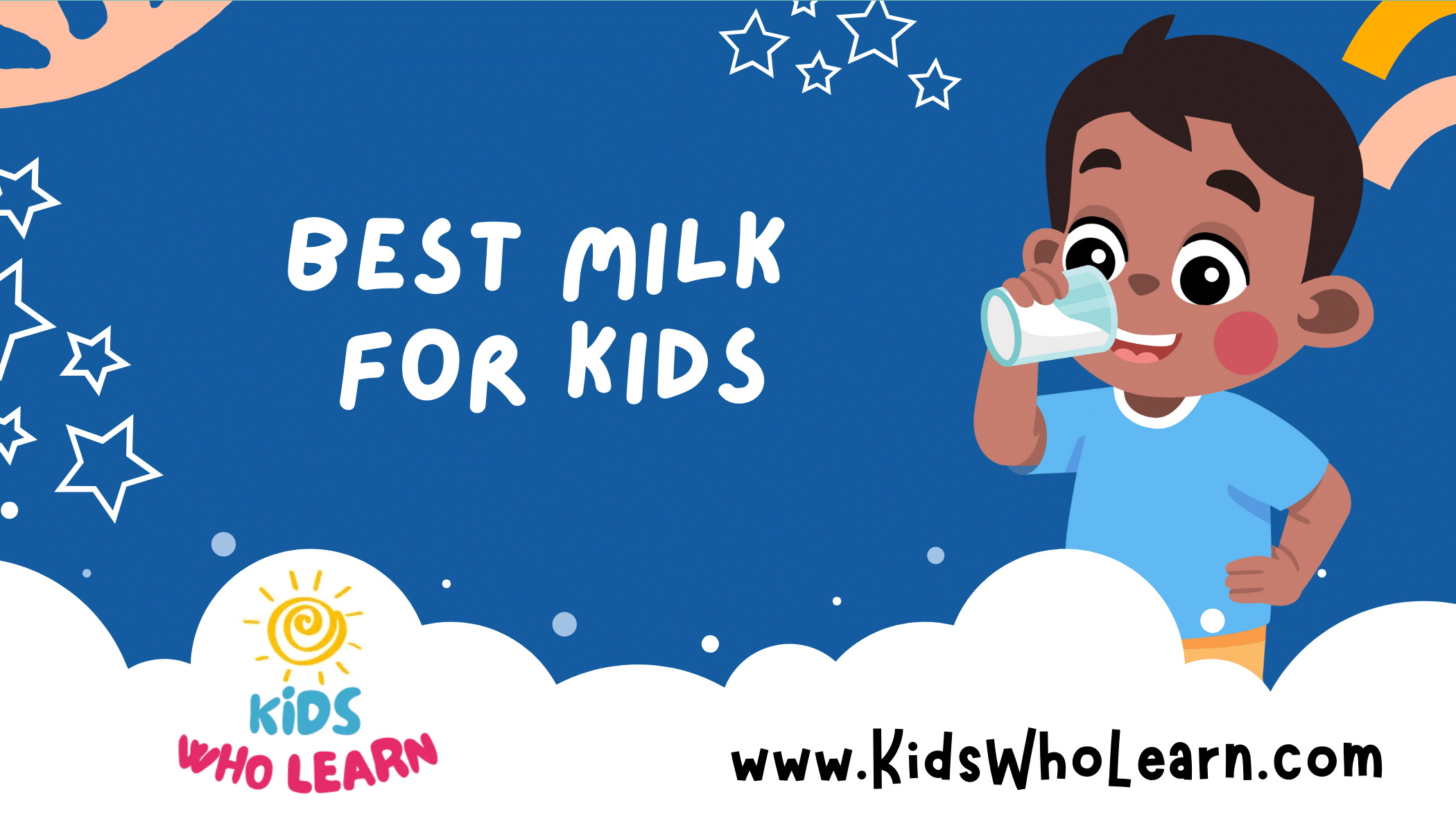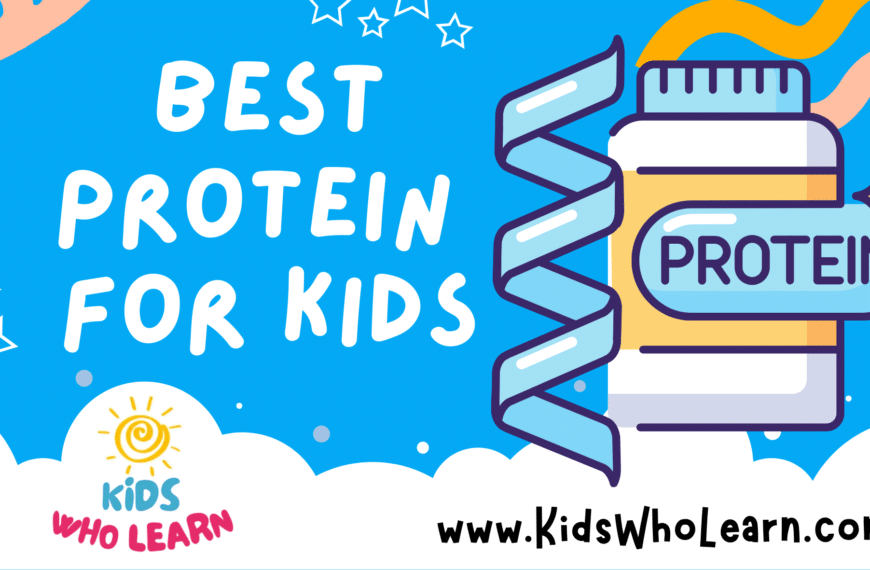Selecting the right milk for your child is a crucial step in supporting their growth and development. Milk is a fundamental component of many children’s diets, offering a rich source of essential nutrients needed for strong bones and overall health. With a variety of options available, from traditional cow’s milk to plant-based alternatives, it’s important to understand which milk is the most beneficial to cater to your child’s dietary needs.
When it comes to the best milk for kids, it’s not just about the type of milk, but also the age-specific nutritional requirements that change as your child grows. Infants have different needs compared to toddlers and older children; therefore, milk choices should align with these changing needs. It’s equally important to consider any health and dietary concerns that might influence which milk to choose. For example, lactose intolerance or milk allergies can significantly impact the choice of milk.
Key Takeaways
- Milk is a key dietary component for children, offering vital nutrients for their growth.
- The best type of milk may vary depending on a child’s age and specific health needs.
- Personal health concerns and dietary preferences should guide the choice of milk for children.
Essential Nutrients in Milk
Milk is a rich source of various essential nutrients that contribute to your overall health, especially in children, whose growing bodies require a steady supply of these components for optimal development.
Proteins and Fat
Milk provides high-quality protein which is vital for the growth and repair of your body tissues. It typically contains about 8 grams of protein per cup, which is crucial for the muscle and bone health of children. The fat content in milk varies depending on the type; whole milk contains more fat, which can be an important energy source for young kids.
Calcium and Bone Health
Calcium stands out as the key nutrient for strong bones and teeth. Children need abundant calcium for the development of bone mass, and milk is one of the most efficient providers, with around 300 milligrams per cup.
- Recommended calcium intake for kids 1-3 years: 700 mg/day
- Recommended calcium intake for kids 4-8 years: 1,000 mg/day
Moreover, milk is often fortified with vitamin D, which enhances calcium absorption and bone growth.
Vitamins and Minerals
Milk is packed with essential vitamins and minerals that are vital for your child’s health:
- Vitamin B12: Essential for brain development and maintaining healthy nerve cells.
- Vitamin A: Supports immune function and vision.
- Potassium: Helps in maintaining normal blood pressure.
- Iron: Although not in high amounts, it is important for reducing the risk of anemia.
- Other minerals: Includes phosphorus, magnesium, and zinc, which play various roles in your body’s biological processes.
Types of Milk and Milk Alternatives
Selecting appropriate milk or milk alternative is important for your child’s nutrition. This section covers different cow’s milk varieties, plant-based milk alternatives, and specialty milks including lactose-free options.
Cow’s Milk Varieties
Cow’s milk is a staple in many children’s diets. It comes in several variants that differ mainly in their fat content:
- Whole Milk: 3.25% milkfat and rich in nutrients, suitable for children above 2 years old unless otherwise advised.
- Reduced-Fat Milk (2%): Lower in fat, yet still provides essential nutrients for growth.
- Low-Fat Milk (1%): Further reduced in fat, while maintaining significant nutritional value.
- Skim Milk (Nonfat): Minimal fat content, often fortified with vitamins A and D.
Plant-Based Milk Alternatives
For children with dairy allergies, lactose intolerance, or those following a vegan diet, plant-based milk alternatives are available:
- Soy Milk: A common non-dairy alternative, rich in protein and often fortified with vitamins and minerals.
- Almond Milk: Typically lower in calories and protein than cow’s milk but high in vitamin E.
- Coconut Milk: Contains beneficial fats known as medium-chain triglycerides (MCTs), but lower in protein.
- Oat Milk: Good source of fiber and often enriched with vitamins and minerals.
- Rice Milk: The least allergenic of milk alternatives but low in protein and often high in carbohydrates.
- Pea Milk: A newer option with a protein content comparable to cow’s milk and soy milk.
Specialty Milks and Lactose-Free Options
For kids with lactose intolerance or those requiring specialized nutrition:
- Lactose-Free Milk: Cow’s milk without lactose, retaining the same nutritional profile as regular milk.
- Fortified Milks: These may include added nutrients like omega-3 fatty acids or added fiber.
When choosing the best milk for your child, consider their nutritional needs, potential allergies, and personal taste preferences. Consult a pediatrician to make an informed choice that contributes to a balanced diet.
Nutrition Considerations for Different Ages
Your child’s nutritional needs evolve rapidly during the first years of life. It’s crucial to provide the appropriate type of milk to support their growth and development at each stage.
Infants and Breastfeeding
Breast milk is the ideal source of nutrition for infants and is usually recommended exclusively for the first 6 months. It is tailored to meet your baby’s needs and contains a perfect balance of nutrients. If you cannot breastfeed or choose not to, infant formula is a carefully designed alternative. Consult your pediatrician to select a formula that’s right for your baby. When it’s time to introduce solid food, typically around 6 months, continue to offer breast milk or formula to complement your baby’s diet until at least 12 months old.
- Exclusively for 0-6 months: Breast milk or infant formula
- 6-12 months: Complement with solid foods while continuing breast milk or formula
Milk for Toddlers 12 Months and Older
Once your child reaches 12 months old, they can start to transition to whole cow’s milk. Whole milk provides essential nutrients, such as calcium and vitamin D, needed for your toddler’s development. Around this age, toddlers usually begin to have a more varied diet with an increased intake of solid foods, making it important to balance their overall nutrition. While whole milk is recommended, some toddlers might require alternatives due to allergies or other health concerns; consult your pediatrician for guidance.
- 12 months and older: Whole cow’s milk or suitable alternative
- Balance with a variety of solid foods
- Consult a pediatrician for personalized advice
Health and Dietary Concerns
Choosing the best milk for your child is a critical decision that takes into account allergies, weight management, and specific dietary needs. It’s important to understand how these factors can influence your child’s health and to select a milk option that aligns with their individual requirements.
Allergies and Intolerances
If your child experiences discomfort or allergic reactions after consuming milk, they might have a milk allergy or be lactose intolerant. Symptoms can range from mild to severe and can include hives, stomach upset, or anaphylaxis. It’s crucial to consult with your pediatrician for an accurate diagnosis, which may involve skin tests or blood tests for allergies, and possibly a hydrogen breath test for lactose intolerance.
Weight Management and Obesity
Regular cow’s milk contains fats that are essential for brain development, but in excess, they can contribute to obesity and high cholesterol. Pay attention to the fat content in milk and consider options like skim or low-fat milk, especially if your child is overweight or has a family history of cardiovascular issues. Lipid screening is recommended by pediatricians to monitor your child’s cardiovascular health, as early dietary management is key in preventing future health problems.
Special Diets and Restrictions
If your child follows a vegan diet or has specific dietary restrictions, it’s essential to choose a milk alternative that meets their nutritional needs without compromising their dietary beliefs or health. Almond, soy, and rice milk are some dairy-free options available, but be sure to check for fortified versions that provide essential nutrients like calcium and vitamin D. Additionally, for children who are lactose intolerant, lactose-free milk is a viable option that retains the nutritional benefits of regular milk without the lactose.
Always read labels carefully and opt for unsweetened varieties to reduce sugar intake.
Choosing the Best Milk for Kids
When selecting the best milk for your child’s growth and development, it’s vital to understand the nutritional content and seek professional guidance.
Reading Labels and Nutritional Information
Reviewing the nutritional labels on milk cartons is essential. Look for key nutrients such as calcium, vitamin D, and protein, which are crucial for bone development. Milk alternatives should also be scrutinized for added sugars and essential nutrients. A well-informed choice requires understanding the American Academy of Pediatrics (AAP) recommendations, which state that children should consume whole milk until the age of two and lower-fat options thereafter.
| Nutrient | Whole Milk | 2% Milk | Almond Milk | Soy Milk |
|---|---|---|---|---|
| Calcium | High | High | Varies | Moderate |
| Vitamin D | Fortified | Fortified | Often Fortified | Often Fortified |
| Protein | High | High | Low | Moderate |
| Added Sugars | None | None | Varies | Varies |
Consulting Healthcare Professionals
Regular discussions with a pediatrician or a registered dietitian will provide personalized advice tailored to your child’s health needs. The healthcare professional can recommend the best milk choice based on your child’s age, growth patterns, and any dietary restrictions. Trust their expertise to align milk selection with the overall dietary recommendations from the AAP, ensuring your child’s nutritional requirements are met for optimal health.
Incorporating Milk into a Child’s Diet
Milk offers vital nutrients such as protein and calcium, which are essential for a child’s growth and bone development. Introducing dairy from sources like milk, yogurt, and cheese through a variety of serving methods ensures that these key elements are included in your child’s daily diet.
Recipes and Serving Ideas
- Smoothies: Combine milk with a mixture of fruits, a spoonful of yogurt, and honey in a blender for a nutritious breakfast or after-school drink.
- Dairy-rich snacks: Offer cheese slices or cubes as a tasty snack that’s packed with protein and calcium.
| Meal | Idea |
|---|---|
| Breakfast | Oatmeal made with milk, topped with a dollop of yogurt |
| Lunch | A cheese sandwich on [whole-grain bread](https://kidswholearn.com/health/nutrition/best-bread-for-kids-2/) with a side of milk |
| Dinner | A creamy soup that uses milk as a base instead of water or stock |
- Encourage milk consumption by involving your child in the kitchen when preparing dairy-based recipes.
Balancing Milk with Other Foods
Balancing milk intake with other foods is necessary for a well-rounded diet.
- Portion control: Serve milk with meals but be mindful of the portions, aiming for 2-3 servings of dairy per day as recommended by pediatric nutrition guidelines.
- Diversify sources of calcium and protein: Include other sources of these nutrients like leafy greens or beans, especially if your family history suggests a need to limit dairy intake due to concerns like lactose intolerance or kidney issues.
- Read labels: When shopping for dairy products at grocery stores, look for items that are lower in sugar, especially flavored milks or yogurts, to maintain a healthy balance.
Remember, while incorporating milk into your child’s diet provides key nutritional benefits, it’s important to consider any dietary restrictions and listen to your child’s tastes and preferences to create a positive and nourishing eating experience.
Milk Safety and Quality
When selecting milk for your children, it is essential to understand the processes of pasteurization and the implications of choosing organic products or those with additives.
Pasteurization and Raw Milk
Pasteurization is a process that heats milk to a specific temperature to destroy potentially harmful bacteria. This process ensures safety, especially for children whose immune systems are not as robust as adults’. When you purchase milk from grocery stores, you are generally buying pasteurized milk, which is safe for your child’s consumption. On the other hand, raw milk has not undergone pasteurization. While some argue it contains beneficial nutrients, it carries a risk of foodborne illnesses and is not recommended for children.
| Milk Type | Process | Safety for Children |
|---|---|---|
| Pasteurized Milk | Heated to destroy bacteria | Recommended |
| Raw Milk | No pasteurization | Not Recommended |
Organic Milk and Additives
Organic milk comes from cows that have not been treated with antibiotics and have been fed with feed free from pesticides. If you choose organic, you are opting for a product with strict production regulations aimed at reducing your child’s exposure to these substances.
Additives in milk, such as vitamins A and D, are often included to boost nutritional value. However, some parents prefer milk without added ingredients or processing aids. It’s important to read labels so you know what is in the milk you are choosing for your family.
| Considerations | Organic Milk | Conventional Milk |
|---|---|---|
| Antibiotics | No antibiotics used | Antibiotics may be used |
| Pesticides | No pesticides in cow feed | Pesticides may be used |
| Additives | Possible natural vitamins/minerals | Additives for enhancement |
Environmental and Ethical Considerations
When selecting milk for your children, it’s crucial to consider the environmental and ethical implications of dairy and its alternatives.
Dairy milk production has significant environmental impacts due to land use, water consumption, and greenhouse gas emissions from cattle. To mitigate these factors, you may opt for milk from local, organic farms that prioritize animal welfare and sustainable practices.
Plant-based milks, such as almond, soy, and oat, offer an alternative with usually lower carbon footprints. However, they vary in their environmental impact:
- Almond milk requires substantial water, primarily in drought-prone areas.
- Soy milk has a moderate environmental impact but is a more water-efficient crop.
- Oat milk is generally considered environmentally friendly due to lower water use and a more favorable carbon footprint.
| Milk Type | Water Usage | Greenhouse Gas Emissions | Ethical Considerations |
|---|---|---|---|
| Dairy | High | High | Animal Welfare |
| Almond | Very High | Moderate | Biodiversity (bee population) |
| Soy | Moderate | Low | Land Use |
| Oat | Low | Low | Crop Rotation Benefits |
Ethical considerations also include the treatment of animals in dairy farms and the impact of plant cultivation on local ecosystems. You’re encouraged to research brands and farms that prioritize ethical practices, including fair labor conditions and biodiversity conservation.
Remember to balance these considerations by assessing the nutritional value each type of milk offers your children, ensuring they receive the necessary nutrients for healthy growth.
Expert Recommendations and Guidelines
The American Academy of Pediatrics (AAP) recommends that children between the ages of 1 and 2 should have whole milk to support their rapid development. According to pediatricians and registered dietitians, the essential fatty acids and vitamin D in whole milk are crucial for brain development during this vital growth period.
From age 2 onwards, the AAP suggests that children can transition to lower-fat milk varieties, such as 2% or skim milk, as part of a balanced diet to help prevent childhood obesity. The USDA Dietary Guidelines echo this advice, suggesting children should consume dairy as part of their daily diet, whilst monitoring saturated fat intake.
For those with lactose intolerance or milk allergies, alternatives like fortified soy milk are recommended by healthcare providers, as they are nutritionally similar to cow’s milk. It is essential to choose products that contain added calcium and vitamin D to meet your child’s nutritional needs.
- Age 1-2: Whole milk (unless otherwise advised by a pediatrician)
- Age 2+: Transition to lower-fat milks; consider lactose-free options if necessary
Consult with your pediatrician or a registered dietitian to personalize milk choices according to your child’s specific health needs, growth pattern, and nutritional requirements. Remember to check packaging for fortification, especially if you opt for milk alternatives.
Frequently Asked Questions
Selecting the right milk is crucial for your child’s nutrition and development. Explore these common questions to make informed choices for your child’s dietary needs.
What are the most nutritious milk options for toddlers?
Whole cow’s milk and fortified plant-based milks are amongst the most nutritious options for toddlers. Whole milk provides essential fats for brain development, while fortified alternatives offer comparable nutrients.
How do I choose the best milk for my 4-year-old to support healthy weight gain?
To support healthy weight gain, look for milks high in healthy fats, like whole cow’s milk, which is calorie-dense and nutrient-rich. Also consider fortified full-fat plant-based milks if you prefer non-dairy options.
Which milk alternatives are recommended for toddlers with dairy allergies?
For toddlers with dairy allergies, fortified plant-based milk such as soy, almond, or oat milk are often recommended. Choose brands that are enriched with calcium and vitamin D to ensure nutritional needs are met.
What factors should I consider when selecting milk for children aged 9 to 12?
For children aged 9 to 12, consider milk’s calcium, protein, and vitamin D content, vital for bone health and growth. Low-fat or skim milk may be appropriate if you’re monitoring caloric intake.
Is organic milk a better choice for young children, and why?
Organic milk can be a preferable option as it is produced without antibiotics, synthetic hormones, or pesticides. Some studies suggest higher omega-3 content, which is beneficial for heart health, although nutritionally it is similar to conventional milk.
Are there specific benefits of Ripple Kids milk compared to other brands?
Ripple Kids milk is a pea protein-based alternative, higher in protein and omega-3s compared to some other plant-based milks. It’s also dairy, nut, soy, and gluten-free, making it suitable for children with allergies.









